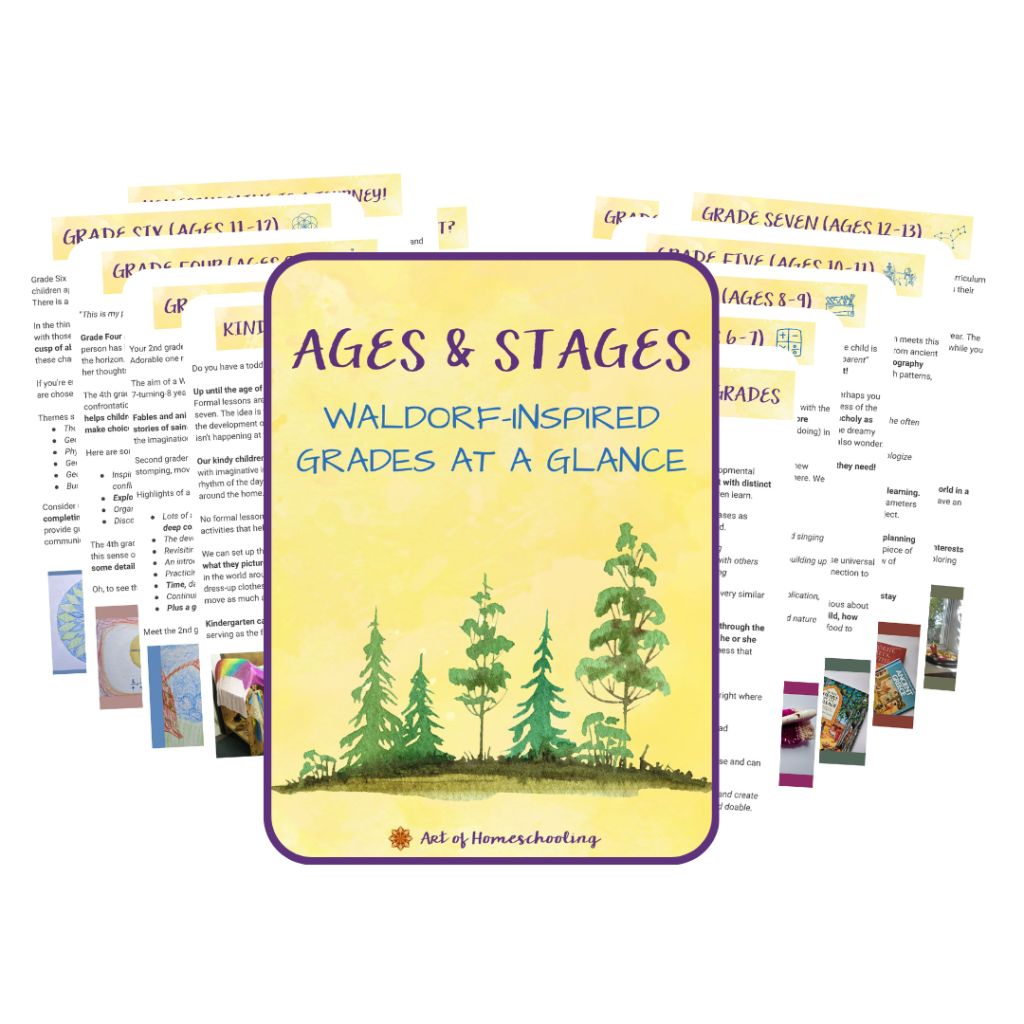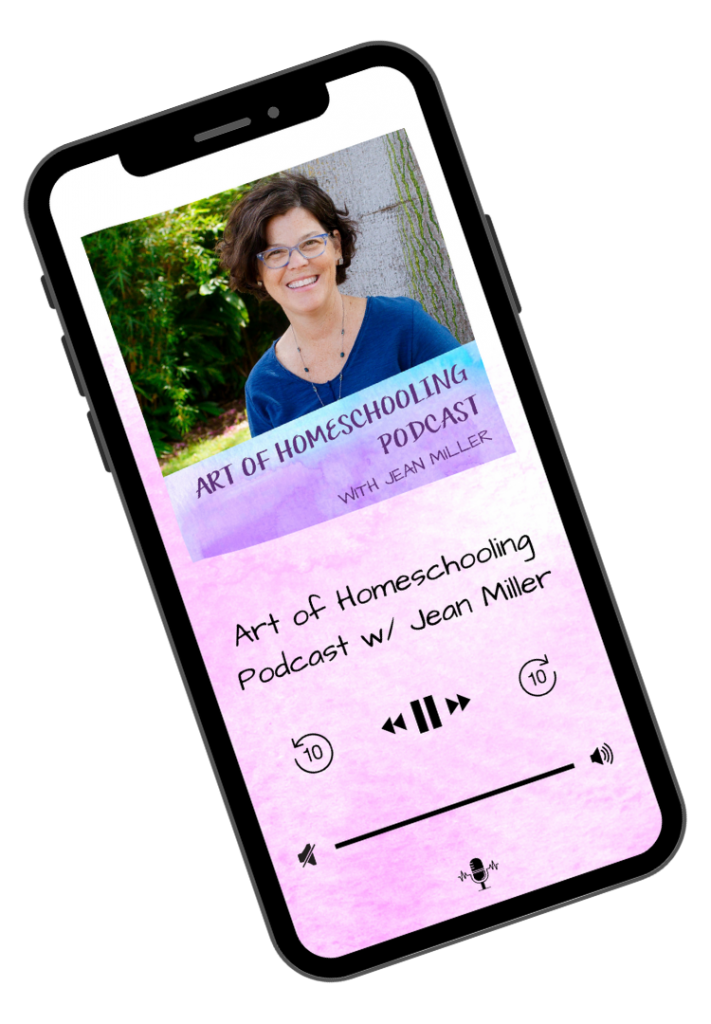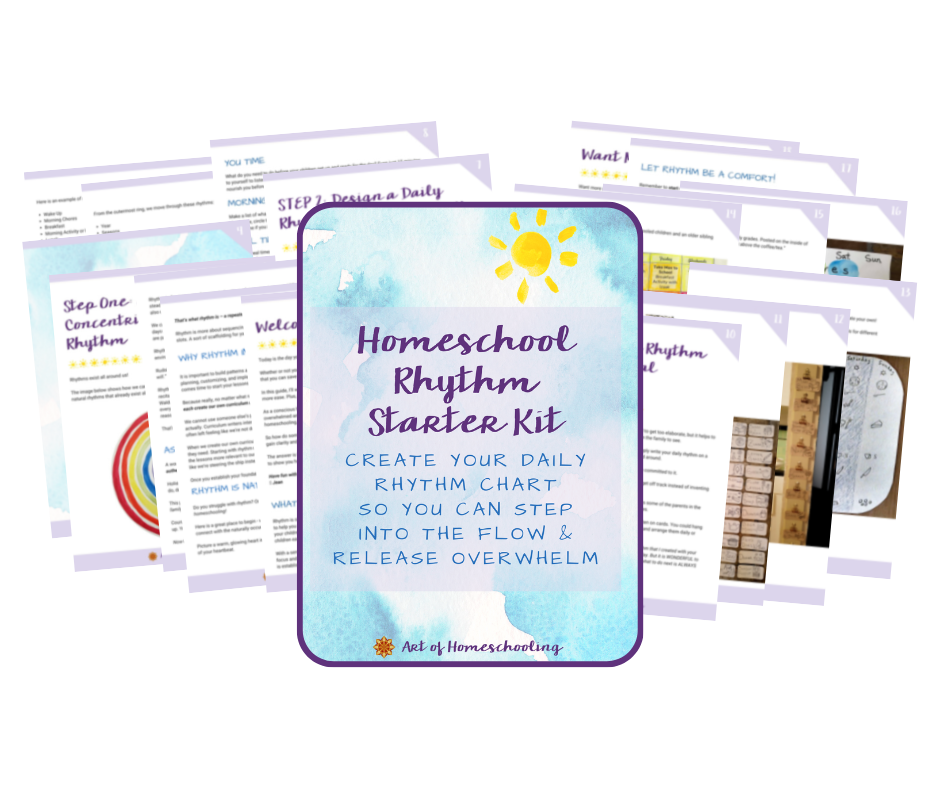Episode 187
Let’s talk about homeschooling second grade! The second grader is a being of extremes! One minute light and loving. The next minute a mischievous little imp. Both adorable and a complete rascal.
This episode of the Art of Homeschooling podcast is one of a series of episodes about homeschooling through the grades. We’re working our way from Kindergarten through Eighth Grade, building a wonderful library for you to refer back to, again and again, whenever you need inspiration and guidance.
You’ll find more about homeschooling through grades in the 🌟FREE🌟Ages & Stages Guide: Waldorf-Inspired Grades at a Glance. This is a wonderful printable resource to keep handy in your homeschool planning binder to give you an overarching picture of the homeschool journey from kindergarten to grade eight.
Be sure to check out Episode 182: The Kindergarten Basket and Episode 185: The First Grade Basket as well.
So let’s dive into our topic, homeschooling second grade! Tap that play button above to listen in to this episode and follow along with the show notes below for highlights, recommended resources, and relevant links.
A Fable for Homeschooling Second Grade
The Fox & the Grapes, an Aesop’s Fable
One hot summer’s day, a Fox was strolling through an orchard ‘till he came to a bunch of grapes just ripening on a vine which had been trained over a lofty branch.
“Just the thing to quench my thirst,” quoth he.
Drawing back a few paces, he took a run, and a jump, and just missed the bunch.
Turning ’round again with a One, Two, Three, he jumped up, but with no greater success.
Again and again, he tried after the tempting morsel.
But at last had to give it up, and walked away with his nose in the air, saying: “I am sure they are sour.”
Stories for Second Grade
I just love this little story because it is so like a 7 or 8-year-old to begin so determined and sure of themselves, only to save face when they fail and hide their disappointment.
We don’t even need to share the moral of the story which is often found at the end of fables because children of this age can so relate to the story itself, and will take in what they need from the story based on where they are developmentally.
When my kiddos were this age, they loved acting out fables like The Fox and the Grapes. I would be the tree and vine, dangling the grapes just out of reach. And they would be the fox, jumping and jumping to try to grab the bunch.
And they loved exaggerating the haughty attitude at the end with the “Never mind! I am sure they are sour” while stomping off with an air of “I didn’t want those grapes anyway.”
I really think it helps children feel seen and heard and even understood just by hearing a story like this one. This is how the stories suggested in the Waldorf curriculum meet children developmentally right where they are.
In the Waldorf-inspired second grade, we bring the child stories of fables, trickster tales, saints, and heroes. These are the stories that will nourish your child this year.
And stories like this are so very much like the 7-turning-8-year-old!
The Second Grade Basket
So what does homeschooling second grade look like for these sweet but sometimes sour little humans?
The second-grade curriculum is very much a continuation of the first-grade curriculum in a Waldorf-inspired homeschool. It includes lots of practice and extending skills development in writing, reading, arithmetic, and nature observation through nature study and stories.
We bring this learning and development to our children through stories and the lively arts.
For more about the story content of second grade, don’t miss the Ages & Stages Guide: Waldorf-Inspired Grades at Glance that I mentioned in the introduction.😉
As homeschooling parents, I think this is a great year for us to focus on the qualities needed in ourselves to meet our children where they are.
Your second-grade basket is a toolkit of patience and diligence, acceptance, and a touch of detachment that you can have handy to meet the challenges and triumphs of this year and those to come.
Patience & Diligence
Second-grade children will all begin the journey through this grade at a different level of skill development. And they’ll each progress at their own pace through the year. This is a year with a broad range of abilities among kiddos and every kiddo is different. And it’s all ok!
You’ll need lots of patience and diligence in your second-grade basket this year!
Homeschooling second grade is really a continuation of first grade, with three main subjects ~ math, language arts, and science.
Be patient and diligent about moving step by step along this learning journey, no matter where your child starts the year. Just continue to move forward at a steady pace.
Math
With math, you’re continuing to practice the four processes of addition, subtraction, multiplication, and division of whole numbers. Be sure to include lots of playful exploration, games, and practice.
Jamie York of Making Math Meaningful says our goals in the early grades include developing a sense of number and an enthusiasm for learning math.
A wonderful resource to reference as you move along this path is Jamie York’s Summary of Math Skills. It’s a free download, so check it out!
Science
For science, you’re continuing to lay a strong foundation of scientific observation through nature study and outdoor experiences. If you want to hear more about this idea, be sure to check out Episode #171 here on the podcast about Nature Study: the Foundation of Science.
Language Arts
Language arts development is all about cracking the code of written language this year. Be patient and carefully observe your child as you progress from introducing the letters of the alphabet through stories and pictures to introducing word families and spelling patterns.
Writing and reading will click at different points for each and every child. Just continue on the path, choosing a spelling or word pattern, looking for examples within your stories to bring this pattern to life for your child, and explicitly working with the pattern in the words, titles, captions, or sentences you compose for your child to copy into his or her main lesson book.
Also, don’t leave out hands-on activities like building words with magnetic letters, tiles, or even natural materials like stones with letters and letter teams printed on them. And be sure to include lots of games and oral language experiences.
There are so many ways to bring these building blocks of language to life for your kiddos through explicit and creative teaching.
Balancing Implicit and Explicit Learning
When the written language code begins to click for your child, you can carefully observe what word patterns they are mastering implicitly or naturally through your shared or partner reading.
Some children will need more explicit instruction than others. And that is totally normal, as long as you continue to make progress.
You might find this quote interesting from the groundbreaking podcast Sold a Story. In Episode 10, host Emily Hanford talks about cognitive researcher, Mark Seidenberg, and his description of this balance between explicit and implicit learning.
“Mark Seidenberg’s research has shown that the brain has a remarkable ability to learn from statistical regularities in language, such as the frequency of certain spelling patterns in words. Explicit instruction is critical at first – most kids don’t just start picking this up. But research shows that a lot of what a good reader eventually knows about words – and how they’re spelled and what they mean – is stuff they learned implicitly, through reading. Mark says the goal of reading instruction should not be to teach kids everything they need to know. It should be to teach them enough so that this implicit or statistical learning can kick in.”
~sold a story episode 10
With careful observation, you’ll find a balance between explicit and implicit learning as you make your way through homeschooling second grade.
A wonderful resource to support you as you move along the path of skills development this year is the Skills Development Masterclass within the Inspired at Home community.
Acceptance
The second thing you will want in your second grade basket or toolkit is a generous helping of acceptance.
The second grader can be a being of extremes! One minute light and loving. The next minute a mischievous little imp.
Children at this age are trying out different behaviors to see what happens. Like scientists with little knowledge of the consequences of their behavior until after the fact.
This can be a wonderful opportunity for us as parents to practice accepting our children for exactly who they are and letting go of who we think they should be.
Detachment
The last quality that the parent of a second grader might find helpful is a pinch of detachment. Interesting one, right?!
The second grader is a child of seven turning eight and still lives partly in the dreamy realm of early childhood. But changes are on the horizon as this little person will soon begin to approach the nine-year change and grow into themselves more and more.
I think it’s so important to protect this stage of childhood as much as possible by allowing the child to play imaginatively, explore and create their own imaginative worlds, and even experience a fair bit of boredom.
And for the parent, this can take some conscious detachment on our part in order to let our children find their way into this imaginative space without direction from us.
Here’s where having your own purposeful work can really be helpful. As the parent, you can be present, nearby, without focusing fully on the child, letting them move through their world of play while you’re within earshot, focusing on your own tasks, but also reassuring them with your presence.
Maybe it’s a knitting project for a neighbor’s new baby, cooking a meal for elderly neighbors, or working in the garden. Whatever is nourishing and within reach for you, with a good balance of rest and activity.
Modeling this focus for your child gives them an example to follow in their work and play and then also in their lessons.
During this year, you can set your daily rhythm to allow for lesson time along with plenty of playtime. With a pinch of detachment on your part, your little second grader can soak up all the goodness of early childhood while still building the skills needed to grow and learn in future years.
Highlights for Homeschooling Second Grade
Here are some highlights from homeschooling second grade with Waldorf inspiration from Ages & Stages Guide: Waldorf-Inspired Grades at a Glance.
Second Grade should include:
- Lots of activities to stimulate the child’s whole being, enliven the will, and spark deep connections with the story and learning material
- The development of skills through playful learning & games
- Block Topic Possibilities
- Animal legends & fables; stories of saints & heroes
- Revisiting all 4 processes of math: addition, subtraction, multiplication, & division
- An introduction to place value through story
- Practicing the times tables 1 through 12 with rhythm and movement
- Time, days of the week, and the calendar
- Continuing along the path of reading and writing development
- Plus a generous dose of all the lively arts!
3 Resources for Your Second Grade Basket
Some of these are referral links. You can read my full disclosure policy here.
- Writing to Reading the Steiner Waldorf Way: Foundations of Creative Literacy in Classes 1 and 2 by Allanson and Teensma
- Aesop’s Fables by Jerry Pinkney or a favorite volume of fables from your public library
- Resources from Jamie York for Math
Be sure to subscribe to the Art of Homeschooling Podcast on your favorite podcast player so you don’t miss an episode.
And don’t miss other episodes in this Ages & Stages series:
- Kindergarten ~ Episode 182: The Kindergarten Basket
- First Grade ~ Episode 185: The First Grade Basket
- Second Grade ~ Episode 187: The Second Grade Basket
- Third Grade ~ Episode 192: The Third Grade Basket
- Fourth Grade ~ Episode 197: The Fourth Grade Basket
- Fifth Grade ~ Episode 201: The Fifth Grade Basket
- Sixth Grade ~ Episode 204: The Sixth Grade Basket
- Seventh Grade ~ Episode 207: The Seventh Grade Basket
- Eighth Grade ~ Episode 210: The Eighth Grade Basket
Until next time!💜

Rate & Review the Podcast
If the Art of Homeschooling Podcast has inspired you, I’d LOVE it if you could rate and review the podcast on your favorite podcast player! Reviews can be left on Apple Podcasts (iTunes), Podcast Addict, or Stitcher.
Or simply pop on over to lovethepodcast.com/artofhomeschooling and choose where you want to leave your review.
And if you want to show your appreciation for the Art of Homeschooling Podcast, you can buy me a cup of tea!
Never Miss an Episode!
Check Out All the Episodes





